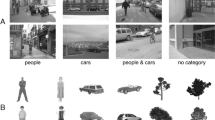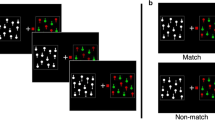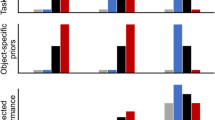Abstract
Human attention plays an important role in human visual system. We assume that the Gestalt law is one of important factors to guide human selective attention. In this paper, we present a series of studies in which we hypothesized that regions of image that get more attention in an object recognition task, confirm to one or more gestalt principles and subconsciously attract human attention which eventually help in object recognition. In our study, we collected attention parts of images by analyzing eye movement of participants. Then we compared Gestalt scores of high attention parts with those of nonattended random parts. Our results suggest that continuity and symmetry of features attract human attention. We argue that an approach to analyze parts with high Gestalt scores can yield better than analyzing random parts of image in object recognition.
Access this chapter
Tax calculation will be finalised at checkout
Purchases are for personal use only
Preview
Unable to display preview. Download preview PDF.
Similar content being viewed by others
References
Anderson, J.R.: Cognitive psychology and its implications, 6th edn., p. 519 (2004)
Erich Rome, F.S., Christensen, H.I.: Computational visual attention systems and their cognitive foundations: A survey. ACM Transactions on Applied Perception (TAP) 7(1), 6 (2010)
Eriksen, C., Hoffman, J.: Temporal and spatial characteristics of selective encoding from visual displays. Perception & Psychophysics, 201–204 (1972)
Eriksen, C., St James, J.: Visual attention within and around the field of focal attention: A zoom lens model. Perception & Psychophysics, 225–240 (1986)
James, W.: The principles of psychology. Harvard UP, Cambridge (1890)
Park, S.-J., An, K.-H., Lee, M.: Saliency map model with adaptive masking based on independent component analysis. Neurocomputing 49, 417–422 (2002)
Jeong, S., Ban, S.-W., Lee, M.: Stereo saliency map considering affective factors and selective motion analysis in a dynamic environment. Neural Networks 21(10), 1420–1430 (2008)
Christianvon, E.: Übergestaltqualitäten. Vierteljahresschriftfür wissenschaftliche Philosophie, 249–292 (1890)
Vassilis, C.: Perception-Action Cycle: Models, Architectures, and Hardware, 1 (2011)
Todorovic, D.: Gestalt principles. Scholarpedia, 5345 (2008)
Beymer, D., Orton, P.Z., Russell, D.M.: An eye tracking study of how pictures influence online reading. In: Baranauskas, C., Abascal, J., Barbosa, S.D.J. (eds.) INTERACT 2007. LNCS, vol. 4663, pp. 456–460. Springer, Heidelberg (2007)
Dou Y, Kong L.: A novel approach based on saliency edges to contour detection. In: International Conference on Audio, Language and Image Processing, pp. 552–556. IEEE Press (2008)
Walther, D.: Selective visual attention enables learning and recognition of multiple objects in cluttered scenes. Computer Vision and Image Understanding, 41–63 (2005)
Rutishauser, U.: Is bottom-up attention useful for object recognition? In: 22th Conference of Computer of Society, vol. 2. IEEE Press, Washington (2004)
Author information
Authors and Affiliations
Editor information
Editors and Affiliations
Rights and permissions
Copyright information
© 2013 Springer-Verlag Berlin Heidelberg
About this paper
Cite this paper
Shen, J., Ojha, A., Lee, M. (2013). Role of Gestalt Principles in Selecting Attention Areas for Object Recognition. In: Lee, M., Hirose, A., Hou, ZG., Kil, R.M. (eds) Neural Information Processing. ICONIP 2013. Lecture Notes in Computer Science, vol 8226. Springer, Berlin, Heidelberg. https://doi.org/10.1007/978-3-642-42054-2_12
Download citation
DOI: https://doi.org/10.1007/978-3-642-42054-2_12
Publisher Name: Springer, Berlin, Heidelberg
Print ISBN: 978-3-642-42053-5
Online ISBN: 978-3-642-42054-2
eBook Packages: Computer ScienceComputer Science (R0)




